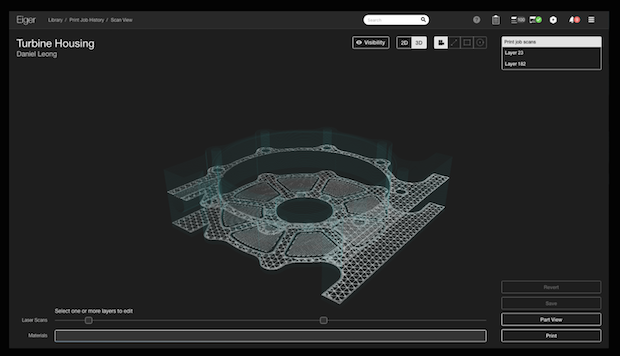In-Process Inspection Aims to Improve 3D Printed Part Quality

The white paper “In-Process Inspection: Improving 3D Printed Parts” looks at how you can inspect a 3D part under fabrication to determine if it is still within tolerance. Image courtesy of Markforged Inc.
Latest News
August 10, 2017
Machines are like people. No one is perfect. They cannot hold your exact dimensions forever. So, designers get into tolerancing to define an acceptable level of variation to fabricate parts that are usable for their intended purpose. But makers still have to qualify finished parts, and qualifying 3D printed parts can be a drag. Once you fling a file at a 3D printer, you can’t be sure tolerances held until you can measure and verify the finished part. Markforged is working on a better way.
Markforged’s Mark X 3D printer sure looks like a techno-lust inducing industrial-scale 3D printing beauty. It can make accurate, smooth and strong-like metal carbon-fiber reinforced parts 13x10x8 in. big. But it also gives you the ability to scan parts during the 3D build process. The white paper “In-Process Inspection: Improving 3D Printed Parts” looks at how you inspect a 3D part under fabrication with the Mark X to ensure that part variability is within tolerance. This enables you to determine if you need to junk that part, tweak a few settings and not waste more time.The operative words are “how you inspect a 3D part.” Humans are still in the loop, but the Mark X has a couple of technologies designed to help loopy humans inspect 3D parts during the build. This paper describes the hardware and software involved. It will be of immense value to current Mark X users and one hefty “did you know this?” for you tire kickers.
 The white paper “In-Process Inspection: Improving 3D Printed Parts” looks at how you can inspect a 3D part under fabrication to determine if it is still within tolerance. Image courtesy of Markforged Inc.
The white paper “In-Process Inspection: Improving 3D Printed Parts” looks at how you can inspect a 3D part under fabrication to determine if it is still within tolerance. Image courtesy of Markforged Inc.Key to the in-process inspection hardware is a printhead-mounted laser displacement sensor. It has 50 micron (diameter) scanning resolution. But it’s the company’s cloud-based Eiger 3D print software with the smarts interpreting sensor data that makes in-process inspection happen.
Basically, you use Eiger to define your tolerance specifications. The Mark X’s laser scans your part during printing. If it detects a non-Eiger sanctioned variance, Eiger lets you know. You then decide what to do – nix the print, blame the new hire or whatever. The upshot is that you can stop and fix problems in-process. That’s bound to save time, reduce scrap material and minimize late-stage rework.
“In-Process Inspection: Improving 3D Printed Parts” also a has a nice little sidebar on adaptive bed leveling, which plays a role here. Brief and nicely illustrated, this paper is well worth your inspection. Hit today’s Check it Out link to download your copy.
Thanks, Pal. – Lockwood
Anthony J. Lockwood
Editor at Large, DE
Subscribe to our FREE magazine, FREE email newsletters or both!
Latest News
About the Author
Anthony J. Lockwood is Digital Engineering’s founding editor. He is now retired. Contact him via [email protected].
Follow DE







 Dear DE Reader:
Dear DE Reader: